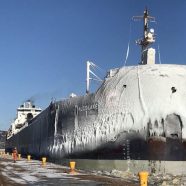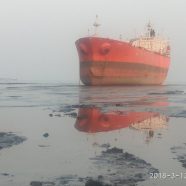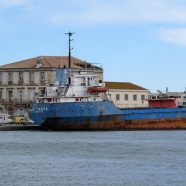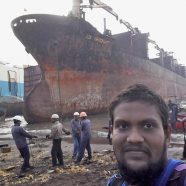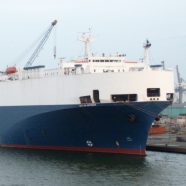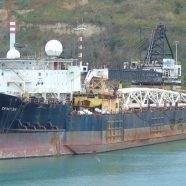Fuego !
The former corvette Alfonso Ceirquera was scuttled off the cliffs of Madeira Island.
In a deafening crash and a grey cloud, the old hull built in the 1970s sank into the Atlantic with its toxic paints, PCB-coated wiring, asbestos and old engines seeping oils and fuel.
“Shipbreaking” #52, the International Shipbreaking Show
Bulletin of information and analysis on end-of-life ships
April 1st to June 30, 2018
83 pages, 235 photos, 95 sources (pdf – 13,1 Mo)
The International Shipbreaking Show #51
An almost dead calm for the beginning of the year but still 222 ships scrapped, or a 34 km-long convoy. Tankers are in the lead. They are heading younger and younger for the demolition beaches especially double hull ships. The Amba Bhavanee demolished in Alang was 15 years old.
In tonnage, Bangladesh is sweeping the board with the temporary ban of oil tankers in Pakistan. China continues being off-side
27% of the ships scrapped belonged to European or EFTA shipowners.
Of 222 ships, only 6% were scrapped in Europe.
Sète in West Africa
Robin des Bois (Robin Hood) suggests that the port of Sète along the Mediterranean Sea be by special derogation incorporated into the Abuja MoU (Memorandum of Understanding), a West African maritime agreement reputed to be non-existent in the quality control of ships calling in the ports of Abidjan, Lomé, Lagos among others.
Indeed the port of Sète and his maritime safety centre are getting ready in the coming days to let the Paris, a Spanish tug, leave Sète towing the Rio Tagus spoiled by rust and water ingress. She is berthed at Sète for 8 years.
Shipbreaking #50, from October 1 to December 31, 2017
– Since Issue # 1 (January 2006), “Shipbreaking” has accompanied 10,026 end-of-life ships, which is to say a 1715 km-long convoy, a tonnage of 87 million tons of scrap metal, about 2 million tons of waste and a US$ 33 billion market. Europe has demolished 219 of them.
– Alert on hazardous towing operations. Will the Puma (ex-Marechiaro, ex-Mira A, ex-Comenda, ex-Salvigour, ex-Yorkshireman) become the new Lyubov Orlova ?
At 62-year old, the ex-Chambord is going to be scrapped.
The Chambord, oil tanker for Société Maritime des Pétroles BP was built in Dunkirk by Ateliers et Chantiers de France. On January 11, 1955, her launch ceremony under the French flag was presided over by Jacques Chaban-Delmas, Minister of Public Works, Transport, and Merchant Navy, in front of a crowd of notable spectators who arrived in two special trains and a fleet of coaches and cars. With her length of 203.39 m, width of 26.25 m, and 33,000 t of deadweight, she was a giant and the flagship of the French oil tanker fleet. Complete with individual, air-conditioned cabins for all, private bathrooms with showers for the officers, cool water dispensers in all of the corridors, refrigerators at all stations, and a saltwater pool, she was a symbol of rebirth and universal progress. Three sisterships left the shipyard in Dunkirk between 1955 and 1958, the Chenonceaux, Cheverny and Chaumont. The Chambord had made her maiden voyage between Marseille and Al Ahmadi (Kuwait) in May 1955. For 17 years, she supplied the French BP refineries.
Robin des Bois shipyard is launching the Shipbreaking #49
– Alert on knowingly wreckless towings of offshore platforms and discarded ships from Northern Europe to Turkey. The case of the two Maersk supply ships sunk off Brittany is dissected. Letter on this subject to the authorities concerned, including the two Maritime Prefects of the French Atlantic coast.
– The end of Shen Neng 1. In 2010, she polluted and degraded the Great Barrier Reef off Queensland, Australia, to gain 2 miles on a 4500-mile return voyage to China.
– The Rio Tagus has been stuck since 2010 or how the French government and the port of Sète are trying to get rid of a bulky wreck.





